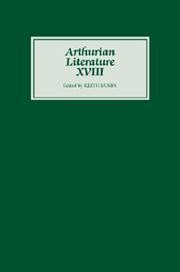Book contents
- Frontmatter
- Contents
- General Editor's Foreword
- I The Composition of the Tristran of Beroul
- II The Lure of the Hybrid: Tristan de Nanteuil, Chanson de Geste Arthurien?
- III L'Extrait du Roman d'Erec et Enide de La Curne de Sainte-Palaye
- IV ‘Talkyng of cronycles of kinges and of other polycyez’: Fifteenth-Century Miscellanies, the Brut and the Readership of Le Morte Darthur
- V Albine and Isabelle: Regicidal Queens and the Historical Imagination of the Anglo-Norman Prose Brut Chronicles
- VI Arthurian Literature, Art, and Film, 1995–1999
General Editor's Foreword
Published online by Cambridge University Press: 05 February 2013
- Frontmatter
- Contents
- General Editor's Foreword
- I The Composition of the Tristran of Beroul
- II The Lure of the Hybrid: Tristan de Nanteuil, Chanson de Geste Arthurien?
- III L'Extrait du Roman d'Erec et Enide de La Curne de Sainte-Palaye
- IV ‘Talkyng of cronycles of kinges and of other polycyez’: Fifteenth-Century Miscellanies, the Brut and the Readership of Le Morte Darthur
- V Albine and Isabelle: Regicidal Queens and the Historical Imagination of the Anglo-Norman Prose Brut Chronicles
- VI Arthurian Literature, Art, and Film, 1995–1999
Summary
Following upon the special issue devoted to the Roman van Walewein, this volume of Arthurian Literature initiates an alternation of miscellanies with theme issues. Varied in their linguistic and chronological coverage, the articles presented in volume XVIII deal with major areas of Arthurian studies, from early French romance through late medieval English chronicle to contemporary fiction. The text of Beroul's Tristan is one of the enduring enigmas of Old French literature: fragmentary and corrupted in transmission but magnificent. Building on more strictly philological work, the late Richard Illingworth's in-depth look at its composition casts new light on the relationship between ‘Beroul’ and his source. Refusing to reopen the debate about single or multiple authorship, Illingworth suggests that it is more fruitful to regard the text as characterized by a process of gradual accretion up to and including the modifications made by the final redactor. The eponymous hero of the little-known Tristan de Nanteuil bears the first name of an Arthurian knight while being primarily a descendant of a celebrated epic lineage. Jane Taylor's essay on this long and complex text explores one aspect of the intertextuality of late medieval French narrative, proposing that we regard the Arthuricity of Tristan de Nanteuil as an attempt to breathe new life into the chanson de geste. Carleton Carroll and Maria Colombo Timelli present the text of an extrait of Chrétien's Erec et Enide prepared by the eighteenth-century scholar La Curne de Sainte-Palaye, indicating the medieval manuscripts to which he had access and explaining his working methods.
- Type
- Chapter
- Information
- Arthurian Literature XVIII , pp. vii - viiiPublisher: Boydell & BrewerPrint publication year: 2001

